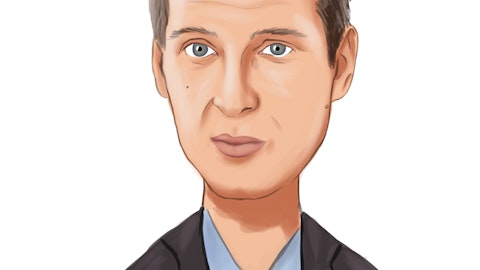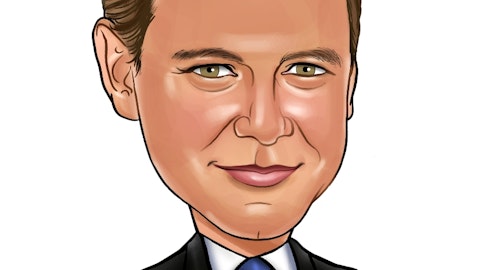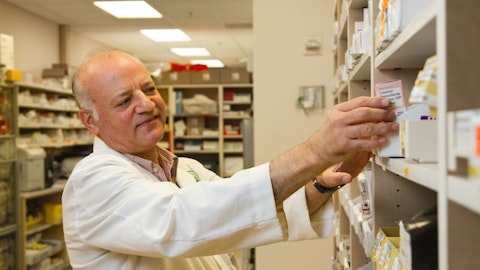John McKew: So we’ve spent a lot of time, Leland, thinking through the best opportunities to advance LUM-201 and past PGHD. PGHD is a great opportunity, I think, for us to show the effect of the molecule on restoring natural pulsatility. And we can take that same mechanism and philosophy and apply it to many of the other 11 indications that are approved for injectable growth hormone. So I think we’re getting to the point where we have the data set, where we can start to think about how to move forward, but we have not yet made any decisions on the exact next step that we’re going to take. But we have, I think, the data and have done the background research on each one of those indications to make some good decisions shortly.
Rick Hawkins: And Leland also recalled, we’ve got a pilot program underway in a broader cardiometabolic opportunity of non-alcoholic fatty liver disease at MGH. Now that’s an investigator initiated trial, but this investigator did demonstrate with a — in a recombinant growth hormone trial in this indication some pretty significant reductions in liver fat in this population. So we’re pretty excited to work with this investigator. I think it’s a little premature right now to talk about anything beyond that, but we’re always looking for ways to increase shareholder value with additional indications.
Leland Gershell: Got it. Rick, so at this point we don’t have to view on when she may have data on her study of 201, correct?
Rick Hawkins: No. She doesn’t have the trial fully enrolled yet, and it’s a six-month trial. So we haven’t really talked about that yet in the marketplace.
Leland Gershell: Okay. We’ll stay tuned, and look forward to hearing updates following your FDA meeting. Thank you.
Operator: Thank you. And our next question coming from the line of Ed White with H.C. Wainwright. Your line is open.
Ed White: Hi. Thanks for taking my questions. So, how should we be thinking about the Phase III start in the fourth quarter? Is that just when you’ll be in opening sites or do you intend or do you think that you can actually treat patients during the fourth quarter?
Rick Hawkins: Okay. Thank you for that question, Ed. And Duke, will you answer that for us? I think you’re on mute.
Duke Pitukcheewanont: Thank you. Yes, sorry about that. Thank you, that was a very good question, right? As of now, we due diligent, like — as John mentioned, right? We already have a plan for the Phase III plan. We get ready to really discuss with FDA what we have planned. In the meantime, we do a prep work, what we need to get done in regards to have a timeline that will be proposed, right? So we think that by the end of this year, we’ll be able to screen the subject and get the timeline enrolled like what we proposed in the past. And I feel very optimistic because, as Rick mentioned earlier, that we have overwhelming requests from the KOL around the world, because they learn about other Phase II results and they do believe that this can be a great potentially the new drug therapy for their patient, the first oral therapy.
So we do believe that a lot of investigators, actually some of those participate in our Phase III trial and some news to LUM-201. However, with the request of participation, we do believe the timeline one, we get these survey up and running and we have a final site identified, I think that the rolling is going to go very quickly and as we proposed in the plan in the past.
Rick Hawkins: And, Ed, obviously we have to finalize the Phase III protocol. We’re obviously working with our vendor partners very actively. It’s good we’ve been active on the podium at all these endocrine meetings around the world. And we’ve contacted and direct contact with really experienced investigators as a result. There’s a lot more work that has to be done in terms of qualifying and activating the sites. And of course, we have our Phase III drug product manufactured and ready to go. So we will have it ready to go. And so, all the preparation that needs to be done, we’re doing right now. And we hope to have plenty of patients screened in the study for the end of the year.
Ed White: Okay. Thanks, Rick, for taking my question.
Operator: Thank you. And our next question coming from the line of Catherine Novack with Jones Research. Your line is open.
Catherine Novack: Oh, hi. Good afternoon, guys. Just one question. Can you remind us of what percent of the OraGrowtH patients enrolled were boys versus girls? And there is difference between how these two populations might be managed by pediatric endocrinologists, a sense that there could potentially encourage patients who might not choose to have a daily injection, try an OraGrowtH hormone therapy instead.


